This post may include affiliate links.
If you make a purchase, I'll earn a small fee at no extra cost to you.
How do you know which melt-and-pour soap base to use? Which one should you pick for your soapmaking project? Here are reviews of the 6 most popular melt and pour soap bases.
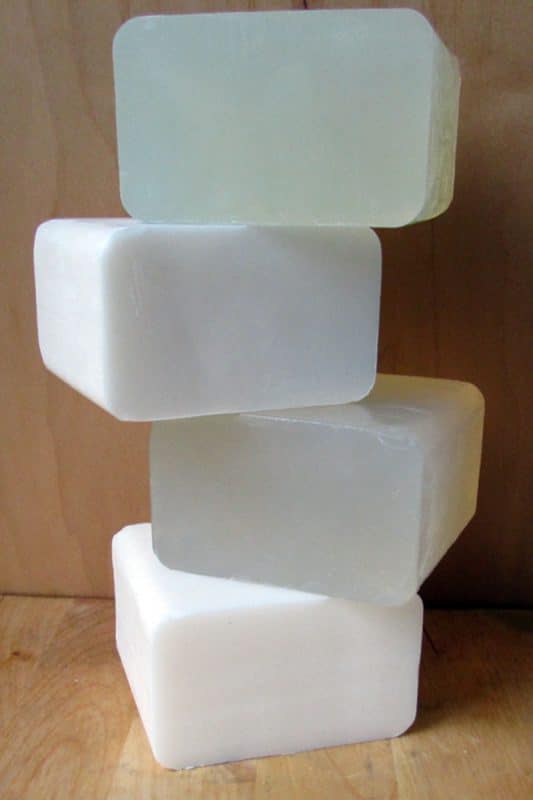
Making soap using the melt-and-pour method is the easiest way to make homemade soap. It’s especially fun and easy with kids, because you aren’t using caustic lye–that part of the soapmaking process has already been done for you.
But how do you know which melt-and-pour soap base to use? A quick Amazon search will give you more than 100 different ones to choose from. Which one should you pick for your soapmaking project?
I’ve done all the hard work of comparing soap bases for you!
Here are reviews of the 6 most popular melt and pour soap bases, what type of skin they are best for, ratings of their bubble-making ability (very important to the 6-year-old), and the different qualities that make some soaps better than others.
Once you’ve decided which base is right for you, here are easy instructions on how to work with your soap base and customize it with herbs and oils.
Here’s how to choose the best melt-and-pour soap base for your soapmaking needs.
Glycerin Melt and Pour Soap Base
The name “glycerin soap” is a bit misleading, because glycerin is present in all soaps. This soap base has additional glycerin added and is processed in a special way so it is translucent.
Features: Glycerin is a humectant, which means it is moisturizing.
Best for: normal to dry skin
Bubble rating: 3 out of 5 for good bubbles.
Shea Butter Melt and Pour Soap Base
Shea butter is made from the nut of the karite tree, which is found in central Africa. It’s used in many natural hair and skin products, including this melt-and-pour soap base, because it helps moisturize and strengthen hair and skin.
Features: Shea butter is moisturizing and nourishing.
Best for: those with dry skin or [cough] mature skin, like me.
Bubble rating: 5 out of 5 for excellent bubbles.
Aloe Vera Melt and Pour Soap Base
This soap base is made in the same way as the glycerin soap base above, and it has aloe vera added. This makes the soap soothing, with a silky texture.
Features: Aloe vera soap is both soothing and healing.
Best for: those with acne.
Bubble rating: 3 out of 5 for good bubbles.
Cocoa Butter Melt and Pour Soap Base
Cocoa butter is the fat from the seeds of the cacao bean–yes, the same plant that gives us chocolate. Cocoa butter melt-and-pour soap base does smell faintly of chocolate, which makes it a great way to start your morning.
Features: besides smelling divine, cocoa butter is rich and moisturizing for the skin.
Best for: Cocoa butter is recommended to help reduce stretch marks. This would be a great soap to make for an expecting mama!
Bubble rating: 4 out of 5 for very good bubbles.
Goat Milk Melt and Pour Soap Base
My first question was, “Why goat milk? Why not cow milk?” It turns out that goat milk is naturally homogenized (the cream doesn’t float to the top, but is evenly distributed throughout the milk). This makes goat milk soap base both rich and moisturizing.
Features: goat milk is nourishing for the skin, and contains vitamins and minerals that help keep skin healthy.
Best for: everyone, but especially helpful for sensitive skin, eczema, roseacea, or problem skin.
Bubble rating: 5 out of 5 for excellent bubbles.
Olive Oil Melt and Pour Soap Base
Remember when doing a “hot oil treatment” on your hair was a big thing? Olive oil is used for hair and skin products, including melt-and-pour soaps, because it’s extremely mild and nourishing.
Features: extremely mild
Best for: the whole family (babies to grandparents).
Bubble rating: 4 out of 5 for very good bubbles.
Once you’ve mastered melt-and-pour soap, you’re ready for the next step!
Making your own soap from scratch is easy with the detailed instructions in The Natural Soapmaking Ebook Collection by The Nerdy Farm Wife.
It contains everything you need to know about making your own natural soaps, milk soaps, and shampoo bars. There are lots of photos and step-by-step instructions. You’ll love it! Click the photo to learn more.

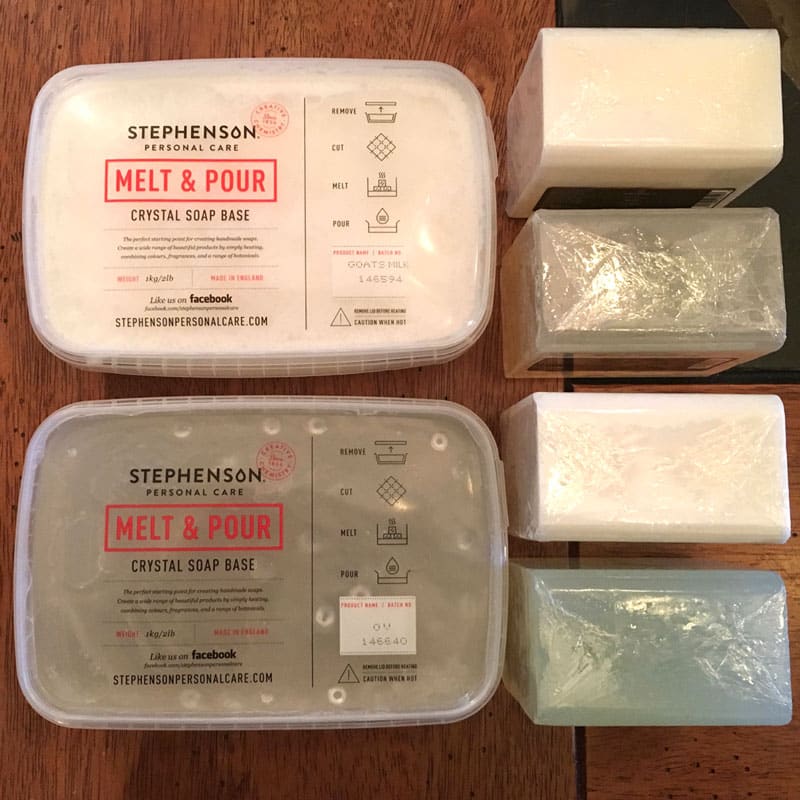

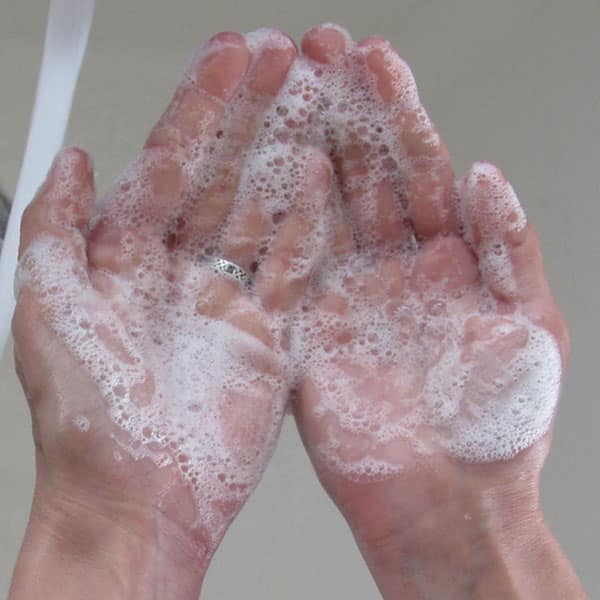
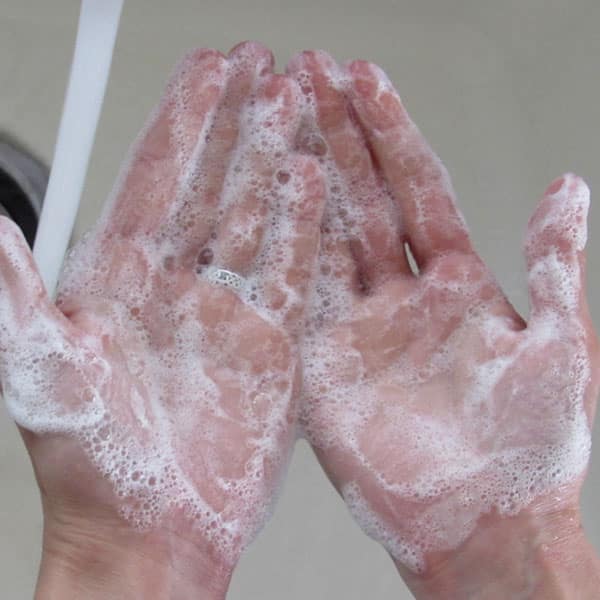

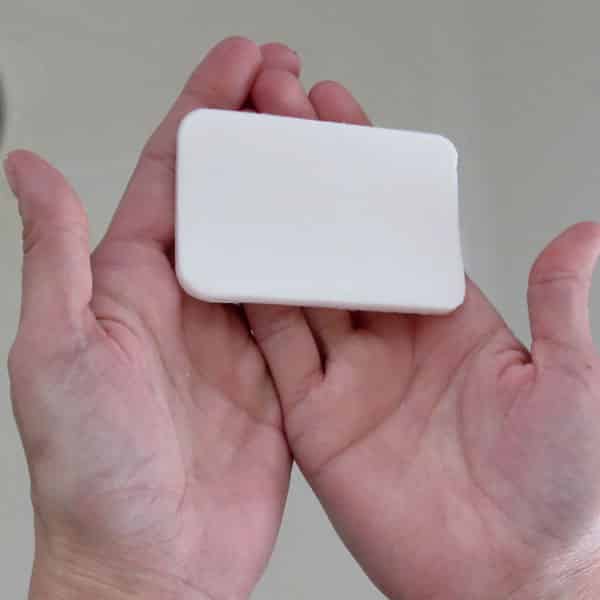
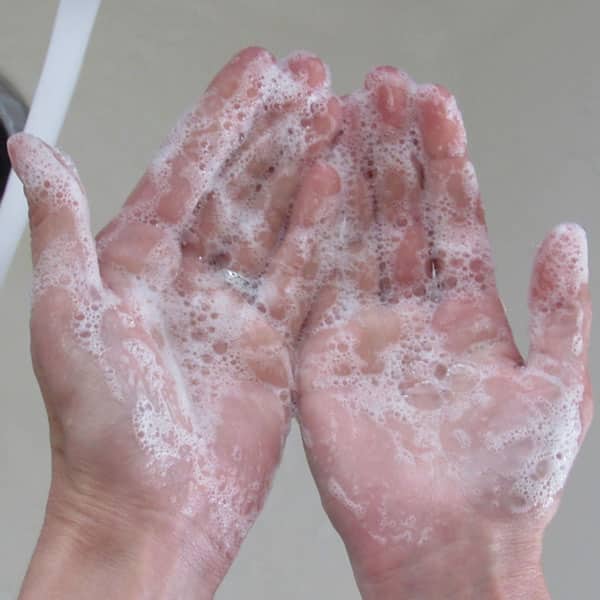
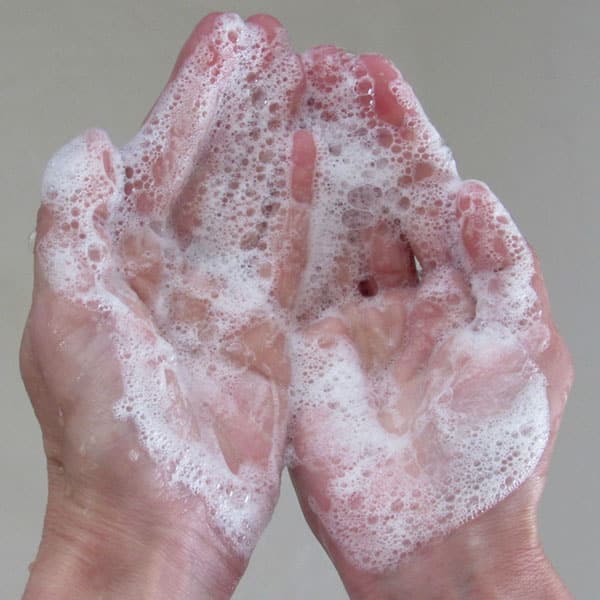

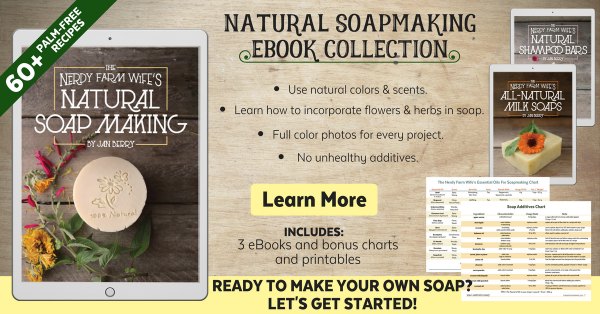
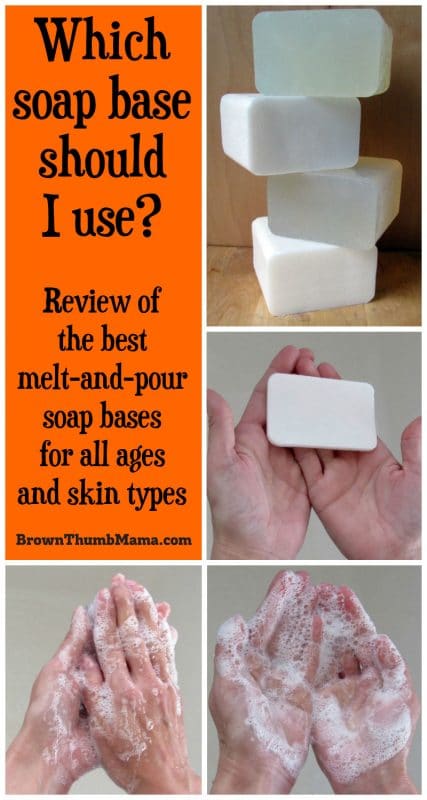


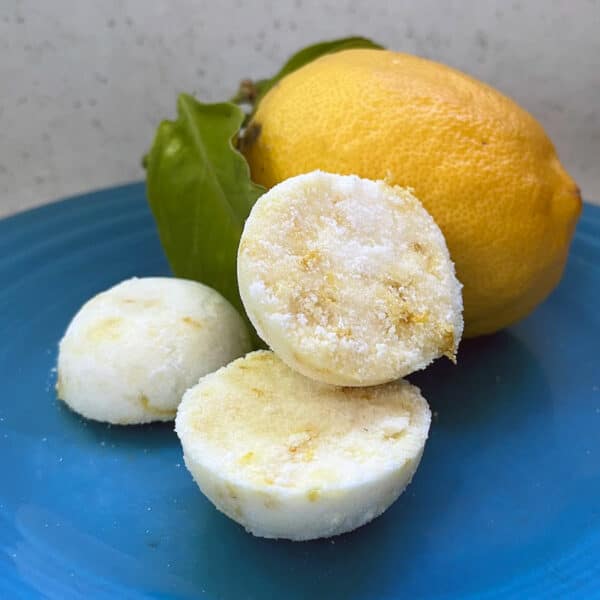
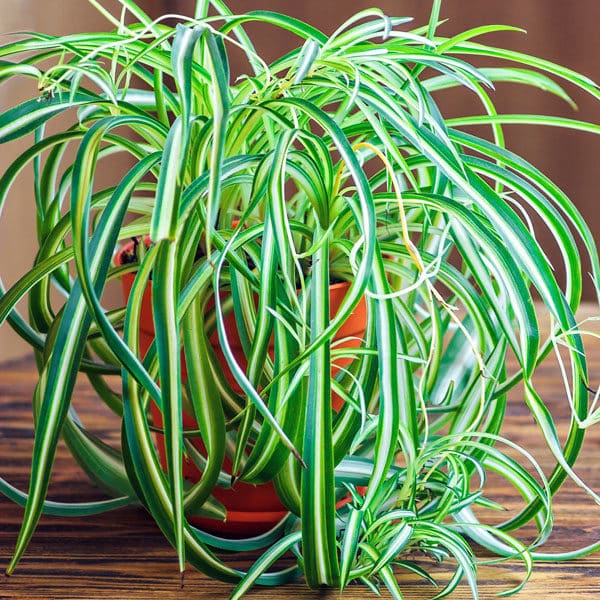
Hi I wanted to start to make my own real non toxic soap.I saw that you use Stephenson which contains Tetra sodium EDTA-This is a preservative that’s made from formaldehyde and sodium cyanide. It is also a penetration enhancer, meaning it breaks down the skin’s protective barrier, going right into your bloodstream. Can you recommend a completely toxic free pour and melt. Thank you, ❤️ Shannon
Excellent post and wonderful blog, this sort of interesting posts I really like, keep it up…
Is white savon blanc soap melt ok to use on babies? I was making breast milk soap for my sons baby acne? But wasn’t sure which base to use I just bought that one because it was the only one in stock
Thank you for you lovely information. I learned alot.
Thank you so very much for the info! I’m new to soap making. This list is soooooooo informative and well put together.
Hi, I make vegan soap and have been noticing that my essential oil is leaching from my SPC Crystal ST MELT AND POUR SOAP BASE after a week or so once I have packaged it up. What am I doing wrong is there any tips
vilataste@gmail.com
Hi. I only have 2 types of glycerine soap base. White, and honey color or lighter.
Can I add coconut butter, or She better or Olive oil to them?
What about White Soap Savon Blanc, is that oil? And is it good for babies ?
From everything I’ve read you have to have lye in order to make soap, otherwise it’s called a beauty bar and I believe if what I’ve read beauty bars are not the best for cleansing.
Thank you, most value information yet, I am a beginner and this is a great starting point for me.
Tracy, I know this is late getting to you, so you may already know this, but the thing about melt and pour soap base is that it is already “soap”. Meaning it already has lye in it. The melt and pour soap bases just take that step and the long curing times out of it. All melt and pour bases are soap.
Also, cleansing bars , depending on how they are made are very affective. They are a lot better for your face and do not dry out your skin. Good examples of this are Lush’s cleansing oil bars. After using you are squeaky clean and moisturized. Wonderful!!!
What is soap made out of? Fat, Water & Lye.
Soaps are sodium or potassium salts of long chain fatty acids. When triglycerides in fat/oil react with aqueous NaOH or KOH(Lye), they are converted into soap and glycerol. This is called alkaline hydrolysis of esters. Since this reaction leads to the formation of soap, it is called the Saponification process.
It’s the chemical reaction that changes the lye from being caustic and the fat from being greasy. Science is awesome!
I have very hard well H2O here in NM any ideas on what to add so I get the 5 of 5 bubbles? I use the goats milk melt and pour and the only place it bubbles is on my hair. I am trying to find different additives to help the bubbles. Any ideas?
Do you have any website about how to make melt and pour soaps?
Because I m trying my hands on melt and pour soaps but my skin feels really dry after using the soap I made ☹️ can you please help me out with a few tips & tricks?
Thanks
I loved this. Very informational, but I didn’t see any soap base for oily or combination skin. What soap bases do I use or additives to help with oily skin? Thank you.
When I looked at the ingredients there was lye in the base!
All soap is made with lye melt and pour bases have already gone through the curing process! The lye is no longer in finished product. Cold Process soap is made with lye but as it cures the lye is no longer there. No lye no soap!
Could anyone answer please. Do you prefer Stephenson over Wholesales supplies plus? Thank you
Hi Kathie,
I am always trying new soap bases. Stephenson is my favorite, and I’ve been really liking Saponify, which is a new company. They have a variety pack of soap bases: https://amzn.to/2WGMNTa
Valerie, I prefer to use Stephenson’s base, I like to mix things into my bars and the suspension property is a little better than with some others so it is dispersed throughout the bar.
What goat milk soap do you recommend? The link just goes to amazon, no specific product.
I have been researching essential oils benefits and making soaps for friends for a few months now. Everyone tells me I should start selling them so registered for my DBA…However have been reading up and if you claim that soap helps with different skin ailments it could be considered a cosmetic or medication. Has anyone had an issue with this and should I go to get FDA certified. Started out as a hobby but it’s really taking off and don’t want to have any problems. I label all ingredients on label and specify for external use only. Anyone have info to help with this.
There can be a warning… search this on googleAs they have examples and be careful of your wording…. but it basically states, this product is not intended to cure or treat any diseases or illness. There are variations but it’s a great CYA…
I would be careful in making any claims that your soap cures or aids in the cure of any skin problem.
Stick to the basics and dont over reach. Use your customers testimonies as to what their experiences
have been with using your soaps. Everysoap is not for Everybody which is the motto I use in my
business. What works for some may not work for all
You can combine bases, or use one and add the other milk/butters for moisturizing properties. I’ve had great success with both.
I’ve used 2 or 3 different kinds of soaps in a layered design
Hi Lisa I live in South Africa, and use African Black soap constantly, suffer with dermititis and really is a fantastic soap, a lot of friends i make for just love it, seems to clear up excema, spots and other skin problems, the best soap ever and totally organic.
Thanks for the info. New to soap making
Sure! The texture might be a little soft, but it should work fine.
Ww my daddy last name is Creasman
William Bill Creasman! aka Bill!
Thank you so very much for the information…it’s the very best detailed info that I’ve found yet…job well done…
Can the bases be mixed? Like, I love goat’s milk anything. But I also like cocoa & shea, would it work if I mixed all 3?
I’ve added raw shea butter to my goats milk base & it came out really good
You can mix bases. It is best to use bases from the same supplier when mixing. Mainly because each formula has a differnt melt point. It will still work mixing different brands, it’s just a little trickier to get it to set up correctly.
Thank you so much for sharing your knowledge about soap-making using natural ingredients. Love it!
Could you test two more soaps? I’m looking for information on the African Black and Triple Butter melt and pour soaps also. FYI: Totally fantastic job on the soaps rating. GREAT IDEA!
Thank you for this! I needed all the info you supplied!
Wonderful! Glad it helped you. 🙂